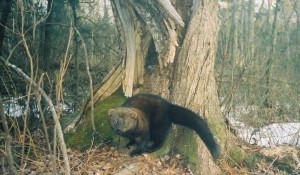Posts Tagged: rat
Accidental dog poisoning on the rise
Veterinarians at the University of California, Davis, warn pet owners to be careful about using rat poisons and similar compounds.
In recent weeks, veterinarians at the UC Davis William R. Pritchard Veterinary Medical Teaching Hospital have seen a spike in accidental rodenticide poisonings. In the last two weeks of August alone, they diagnosed and treated six canine cases.
If not treated, a dog can die within a week of ingesting rodenticides.
"This is an all-too-common occurrence," said Karl Jandrey, assistant professor of clinical small animal emergency and intensive care at UC Davis. "People are trying to get rid of unwanted rodents, but are not realizing what these toxins do to the other animals who share that environment."
Keeping pets safe
Using proper pest control techniques can help keep family pets safe, said Roger Baldwin, UC Cooperative Extension advisor with the UC Integrated Pest Management Program. Baldwin, a wildlife pest management expert, is based at the UC Kearney Agricultural Research and Extension Center in Parlier.
Dogs can be affected by rodenticides two ways: by eating the poisoned bait or by eating an animal that was poisoned. Both can have serious consequences.
Home improvement stores like Lowes and Home Depot, and even grocery stores, carry a variety of products that may be used to control unwanted rats, mice, pocket gophers and ground squirrels. If the unwanted animals are inside the house, Baldwin recommends using traps rather than poison.
"If a poisoned animal dies behind a wall, you can't get it out and you have to live with the smell for weeks or months," Baldwin said.
Also, before baiting outdoor pests, Baldwin suggests making sure they are not also going inside buildings. If they are, find all potential access points and close them up.
If resorting to poison baits, buy a new product at the store and carefully read the label to understand when, where and how it can be used. Because of rapidly changing restrictions in recent years, old products in your garage or shed could be outdated.
Pocket gopher bait must be placed in the gopher's underground burrow. Even there, Baldwin said, certain dogs will dig up dead pocket gophers if they are close enough to the surface. Families with digging dogs will likely want to choose gopher traps. For ground squirrels, baits can be placed in bait stations or scattered very thinly on the ground through broadcast or spot treatments.
"When you use broadcast or spot treatments, there is relatively little danger to dogs or cats," Baldwin said. "But I would opt to use bait stations in my yard if I had pets running around, just to be on the safe side."
Some rodenticides contain ingredients that are anticoagulants, which slow the clotting of the blood. When dogs ingest these poisons, the active ingredients concentrate in the liver where they interfere with vitamin K storage and the production of blood clotting factors.
At UC Davis' veterinary teaching hospital, dealing with accidental poisoning by an anticoagulant rodenticide can require around-the-clock care with treatments in the intensive care unit to replenish blood clotting factors with fresh frozen plasma and replace vitamin K. If administered early enough, this treatment usually leads to a full recovery. Other rodenticides (e.g., bromethalin, cholecalciferol, strychnine and zinc phosphide) do not have antidotes, so treatment is more difficult.
One patient recently treated at UC Davis was Mocha, a one-year-old Belgian Malinois from Winters, Calif. Mocha had gotten into d-CON, a common rodenticide available at hardware stores.
Luckily, Mocha was brought to the veterinary teaching hospital in time. She responded well to treatment and was able to go home in two days.
"We are grateful for the care Mocha received at UC Davis," said Ken Shaw, Mocha's owner. "Like most dogs, Mocha is adventurous and likes to get into things she shouldn't. But after the treatment at UC Davis, she was home within a few days, happy and playful once again."
Poisons on public lands put wildlife at risk
Rat poison used on illegal marijuana farms may be sickening and killing the fisher, a rare forest carnivore that makes its home in some of the most remote areas of California, according to a team of researchers led by University of California, Davis, veterinary scientists.
Researchers discovered commercial rodenticide in dead fishers in Humboldt County near Redwood National Park and in the southern Sierra Nevada in and around Yosemite National Park. The study, published July 13 in the journal PLoS ONE, says illegal marijuana farms are a likely source. Some marijuana growers apply the poisons to deter a wide range of animals from encroaching on their crops.
Fishers in California, Oregon and Washington have been declared a candidate species for listing under the federal Endangered Species Act. Fishers, a member of the weasel family, likely become exposed to the rat poison when eating animals that have ingested it. The fishers also may consume rodenticides directly, drawn by the bacon, cheese and peanut butter “flavorizers” that manufacturers add to the poisons.
Other species, including martens, spotted owls, and Sierra Nevada red foxes, may be at risk from the poison, as well.
“Our findings were very surprising since non-target poisoning from these chemicals is typically seen in wildlife in urban or agricultural settings,” said lead author Mourad Gabriel, a UC Davis Veterinary Genetics Laboratory researcher and presid
ent of the Integral Ecology Research Center. “In California, fishers inhabit mature forests within the national forest, national parks, private industrial and tribal community lands – nowhere near urban or agricultural areas.”“I am really shocked by the number of fishers that have been exposed to significant levels of . . . anticoagulant rodenticides,” said pathologist Leslie Woods of the UC Davis California Animal Health and Food Safety Laboratory System.
Exposure to the poison was high throughout the fisher populations studied, complicating efforts to pinpoint direct sources. The fishers, many of which had been radio-tracked throughout their lives, did not wander into urban or agricultural environments. However, their habitat did overlap with illegal marijuana farms.
Gabriel said fishers may be an “umbrella” species for other forest carnivores. In ecology, an umbrella species is one that, if protected, results in protection of ot
her species, as well.“If fishers are at risk, these other species are most likely at risk because they share the same prey and the same habitat,” said Gabriel. “Our next steps are to examine whether toxicants used at illegal marijuana grow sites on public lands are also indirectly impacting fisher populations and other forest carnivores through prey depletion.”
In addition to UC Davis, the study involved researchers from the nonprofit Integral Ecology Research Center, UC Berkeley, United States Forest Service, Wildlife Conservation Society, Hoopa Tribal Forestry, and California Department of Fish and Game.
(This article was condensed from a UC Davis news release. Read the full press release and watch a flash video of fishers in the wild.)




